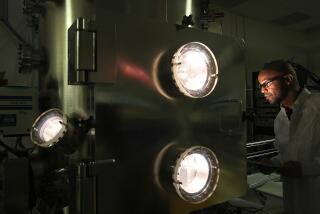Huntington Library aerospace exhibition looks at industry’s influence
Southern California’s aerospace industry — from the early days of pioneers such as Jack Northrop, Howard Hughes and Donald Douglas to today’s robotic drones — will be explored in a new exhibition in San Marino.
Beginning Saturday, the Huntington Library will showcase the aerospace industry’s influence on Southern California in the 20th century. The exhibition aims to show how the industry transformed the Southland from a land of orange groves to a high-tech metropolis.
Photos: 100 years of Southland aviation history
“Southern California as we know it would not exist without aerospace,” said Peter Westwick, director of the Huntington Library’s aerospace history project. “It changed the culture and geography of the region and has had a lasting economic impact throughout the decades.”
Three years in the making, “Blue Sky Metropolis: The Aerospace Century in Southern California” features reams of manuscripts, documents and photographs drawn from the library’s collection of aerospace-related materials and other private and public collections.
There is also an RS-18 rocket engine, early satellite models and a replica of a mid-century engineer’s desk with tools of the engineer’s trade: slide rules, French curves and a mechanical calculator.
The archived material is on display in bright glass cases spread over a modest 800-square-foot area in the west hall of the library. The photos and documents are installed chronologically by era, beginning with the barnstorming aviators of the early 1900s and finishing with modern day innovators like Hawthorne rocket venture Space Exploration Technologies Corp., or SpaceX.
“We wanted to highlight the key moments in history,” Westwick said. “The importance of aerospace has been lost on people — especially younger people — living in Southern California. We wanted to preserve the history while we still could.”
The endeavor started after a public conference held at the Huntington in 2007 in which former aerospace leaders spoke about the industry.
“More than 200 people showed up,” said David S. Zeidberg, director of the library. “It was a tremendous response. People were hungry for information.”
It wasn’t long before Westwick and his colleagues began asking for documents and photos from aerospace companies and former workers. They obtained drawings and photographs of skeletons of planes and wings, including Lockheed Corp.’s wooden six-passenger Vega monoplane of the 1920s and the titanium SR-71 Blackbird Cold War-era spy plane of the 1960s.
“Nobody else was collecting this stuff,” Westwick said. “We said, ‘Well, we’ll do it.’ ”
His crew also began conducting interviews with retired test pilots, aerospace engineers and technicians who worked on the technology. The subjects ran the gamut from the engineers who helped put man on the moon to workers who toiled in secrecy on Cold War projects.
“People would show up with their spouses or other family members who’d be hearing their stories for the first time,” Westwick said. “For the longest time, they couldn’t talk about what they did. Here they are — all this time later — divulging these stories.”
The exhibition includes pictures of industry powerhouses such as Lockheed, Northrop, Douglas and Hughes Aircraft but also conveys their social influence. For instance, fun-loving engineers used their wing-design know-how to improve their surf boards. There is a 7-foot wooden surfboard standing in the exhibit to showcase that.
The exhibition also depicts how the workplace diversified to include more women and minorities during World War II, when aircraft manufacturing boomed in California, with factories running around the clock. The industry was so robust that communities such as Lakewood were spawned to house workers.
“It’s not just about what the industry built, it’s also about who they were as people,” Westwick said. “We hope that after the exhibit opens more people will step forward to tell their story. In many ways we’re just at the beginning.”







